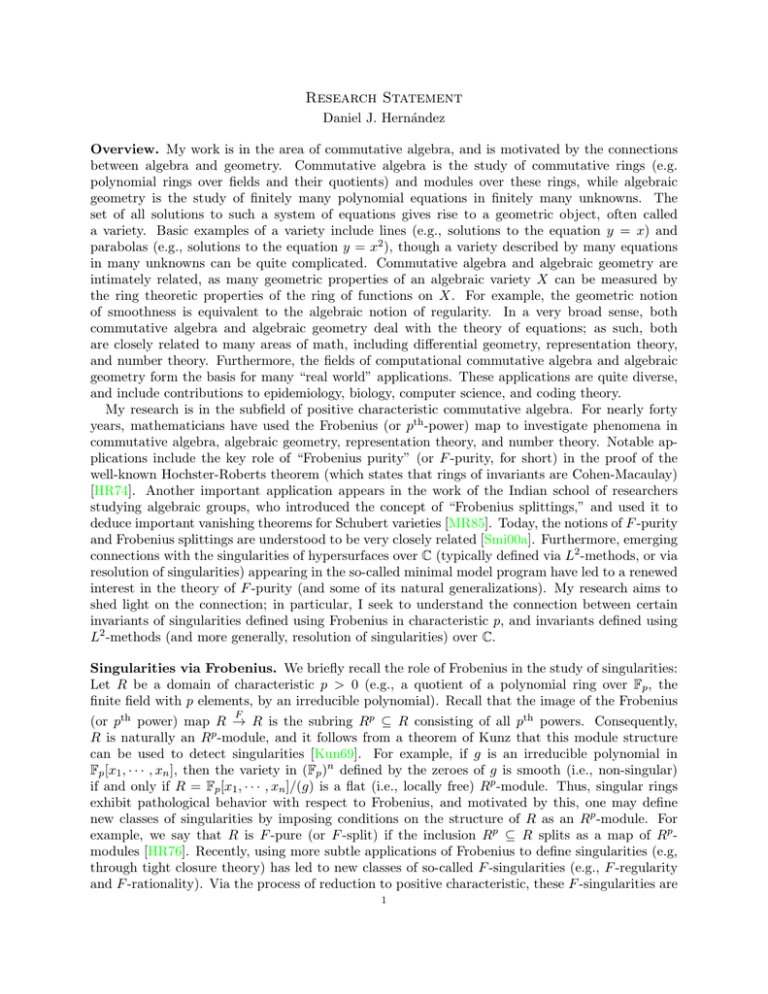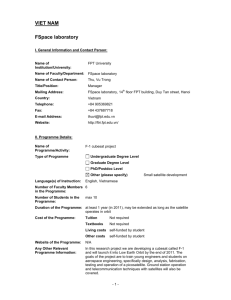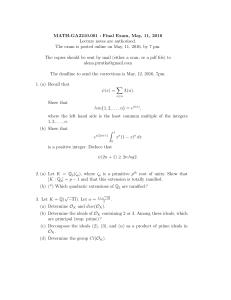Research Statement
advertisement

Research Statement
Daniel J. Hernández
Overview. My work is in the area of commutative algebra, and is motivated by the connections
between algebra and geometry. Commutative algebra is the study of commutative rings (e.g.
polynomial rings over fields and their quotients) and modules over these rings, while algebraic
geometry is the study of finitely many polynomial equations in finitely many unknowns. The
set of all solutions to such a system of equations gives rise to a geometric object, often called
a variety. Basic examples of a variety include lines (e.g., solutions to the equation y = x) and
parabolas (e.g., solutions to the equation y = x2 ), though a variety described by many equations
in many unknowns can be quite complicated. Commutative algebra and algebraic geometry are
intimately related, as many geometric properties of an algebraic variety X can be measured by
the ring theoretic properties of the ring of functions on X. For example, the geometric notion
of smoothness is equivalent to the algebraic notion of regularity. In a very broad sense, both
commutative algebra and algebraic geometry deal with the theory of equations; as such, both
are closely related to many areas of math, including differential geometry, representation theory,
and number theory. Furthermore, the fields of computational commutative algebra and algebraic
geometry form the basis for many “real world” applications. These applications are quite diverse,
and include contributions to epidemiology, biology, computer science, and coding theory.
My research is in the subfield of positive characteristic commutative algebra. For nearly forty
years, mathematicians have used the Frobenius (or pth -power) map to investigate phenomena in
commutative algebra, algebraic geometry, representation theory, and number theory. Notable applications include the key role of “Frobenius purity” (or F -purity, for short) in the proof of the
well-known Hochster-Roberts theorem (which states that rings of invariants are Cohen-Macaulay)
[HR74]. Another important application appears in the work of the Indian school of researchers
studying algebraic groups, who introduced the concept of “Frobenius splittings,” and used it to
deduce important vanishing theorems for Schubert varieties [MR85]. Today, the notions of F -purity
and Frobenius splittings are understood to be very closely related [Smi00a]. Furthermore, emerging
connections with the singularities of hypersurfaces over C (typically defined via L2 -methods, or via
resolution of singularities) appearing in the so-called minimal model program have led to a renewed
interest in the theory of F -purity (and some of its natural generalizations). My research aims to
shed light on the connection; in particular, I seek to understand the connection between certain
invariants of singularities defined using Frobenius in characteristic p, and invariants defined using
L2 -methods (and more generally, resolution of singularities) over C.
Singularities via Frobenius. We briefly recall the role of Frobenius in the study of singularities:
Let R be a domain of characteristic p > 0 (e.g., a quotient of a polynomial ring over Fp , the
finite field with p elements, by an irreducible polynomial). Recall that the image of the Frobenius
F
(or pth power) map R → R is the subring Rp ⊆ R consisting of all pth powers. Consequently,
R is naturally an Rp -module, and it follows from a theorem of Kunz that this module structure
can be used to detect singularities [Kun69]. For example, if g is an irreducible polynomial in
Fp [x1 , · · · , xn ], then the variety in (Fp )n defined by the zeroes of g is smooth (i.e., non-singular)
if and only if R = Fp [x1 , · · · , xn ]/(g) is a flat (i.e., locally free) Rp -module. Thus, singular rings
exhibit pathological behavior with respect to Frobenius, and motivated by this, one may define
new classes of singularities by imposing conditions on the structure of R as an Rp -module. For
example, we say that R is F -pure (or F -split) if the inclusion Rp ⊆ R splits as a map of Rp modules [HR76]. Recently, using more subtle applications of Frobenius to define singularities (e.g,
through tight closure theory) has led to new classes of so-called F -singularities (e.g., F -regularity
and F -rationality). Via the process of reduction to positive characteristic, these F -singularities are
1
closely related to the singularity types of varieties defined over C (e.g., log canonical and rational
singularities) that appear in the so-called minimal model program, a major area of research in
birational geometry [Fed83, Smi97a, Har98, Smi00b, KM98]. My research is especially motivated
by the connection between F -purity and log canonical singularities.
Outline. The research discussed here is organized into the following sections:
Section 1: F -pure thresholds versus log canonical thresholds. The research discussed
in Section 1 revolves around an important conjecture relating F -purity and log canonicity: We
seek to investigate when (and how often) F -pure and log canonical thresholds agree, as well as to
investigate arithmetic properties of the F -pure threshold whenever it differs from the log canonical
threshold. We conclude this section by discussing a project motivated by Elkies’ theorem on the
existence of infinitely many supersingular primes for an elliptic curve over Q.
Section 2: Explicit Formulas via congruence classes. Here, we seek to understand when
explicit formulas for F -pure thresholds (and related characteristic p > 0 invariants) exist; in the
case that any formulas may be calculated, we propose to study in what ways these formulas depend
on the class of p modulo some integer. As an application, we discuss projects related to a recentlyobserved connection with Bernstein-Sato polynomials in characteristic zero.
Section 3: Test ideals and F -jumping exponents. In this section, we propose to study
test ideals, invariants in characteristic p that may be thought of as analogs of the multiplier ideals,
typically defined over C. One group of projects involves an associated sequence of numerical
invariants called F -jumping exponents, while others focus on producing algorithms for computing
test ideals and F -jumping exponents.
1. F -pure thresholds versus log canonical thresholds
Given a polynomial fQ over Q, one may use resolution of singularities to construct the birational
invariant lct(fQ ), called the log canonical threshold of fQ [Laz04]. Note that lct(fQ ) ∈ Q ∩ (0, 1],
and as the name suggests, log canonical thresholds may also be defined using the notion of log
canonical singularities, a prominent singularity type in the minimal model program.
For p 0, one may reduce the coefficients of fQ mod p to obtain polynomials fp ∈ Fp [x1 , · · · , xn ];
one upshot of reducing
to characteristic po is that one may now use Frobenius to study fp . If we set
n
e
e
/ (xp1 , · · · , xpn ) , then the limit fpt(fp ) := lim p−e · νfp (pe ) exists, and is
νfp (pe ) := max N : fpN ∈
e→∞
called the F -pure threshold of fp [TW04, MTW05]. Like lct(fQ ), we have that fpt(fp ) ∈ Q ∩ (0, 1]
[BMS08]. In fact, the connection between these two invariants runs far deeper [MTW05]:
(1)
fpt(fp ) ≤ lct(fQ ) for p 0, and lim fpt(fp ) = lct(fQ ).
p→∞
∈ Q[x, y], then fp =
− y 2 ∈ Fp [x, y]. Furthermore, for p ≥ 5,
(
lct(fQ )
p ≡ 1 mod 6
.
lct(fQ ) = 65 , and fpt(fp ) =
1
lct(fQ ) − 6p p ≡ 5 mod 6
Example 1. If fQ =
x3
−
y2
x3
Conjecture 2. [MTW05, Conjecture 3.6] fpt(fp ) = lct(fQ ) for infinitely many p.
Conjecture 2 represents one of the most important open problems in the field, and is closely
related to other open arithmetic problems [MS11, Mus12]. Note that Conjecture 2 holds in Example
1 by Dirichlet’s Theorem on primes in arithmetic progressions. However, Conjecture 2 can be quite
subtle in general. In the case that fQ ∈ Q[x, y, z] defines an elliptic curve E ⊆ P2Q , Conjecture 2 is
closely related to the result which states that the reduction Ep is supersingular for infinitely many
p; see [MTW05, Example 4.6] for more details.
Project 3. Address Conjecture 2 (and its natural generalizations).
2
The author has recently identified some special cases in which Conjecture 2 is “attackable.”
Indeed, given a polynomial fC over C, one may apply the process of “reduction to characteristic
p” to obtain models fp over finite fields of characteristic p 0 [Smi97b]; in the case that fC
has coefficients in Q, this process recovers the one discussed earlier. In this setting, one may ask
whether fpt(fp ) = lct(fC ) for infinitely many p, and I have has answered this question in the
affirmative whenever the coefficients of the polynomial fC are algebraically independent over Q
[Herb]. Moreover, I suspect that one may be able to use these methods to address a version of
Conjecture 2 for more general varieties. Note that one first step in this direction was recently taken
by Shunsuke Takagi, who generalized the methods I developed in [Herb] to obtain a positive answer
to a variation of Conjecture 2 in the setting of an ambient space with mild singularities [Tak11].
Project 4. Recall that fpt(fp ) ∈ Q ∩ (0, 1], and suppose that fpt(fp ) 6= lct(fQ ).
(1) (Karl Schwede) Must p divide the denominator of fpt(fp )?
(2) When is the denominator of fpt(fp ) a power of p?
In ongoing joint work with Luis Nuñez Betancourt, Emily Witt, and Wenliang Zhang, we have
generalized Bhatt and Singh’s argument in [BS] to obtain the following.
Theorem 5. [HNBWZ] Let fQ ∈ Q[x,Py] be quasi-homogeneous with isolated singularity, and
−s is the base p expansion of lct(f ), then there
suppose fpt(fp ) 6= lct(fQ ). If lct(fQ ) = ∞
Q
s=1 βs · p
PLp
exists an integer Lp ≥ 1 such that fpt(fp ) = s=1 βs · p−s (i.e., a truncation of lct(fQ ), base p).
In the context of Theorem 5, we conclude that fpt(fp ) is a truncation of the base p expansion
of lct(fQ ), and this addresses the second point of Project 4. In fact, the denominator of fpt(fp )
is always a power of p whenever fQ is quasi-homogeneous with isolated singularity and fpt(fp ) 6=
lct(fQ ), even though fpt(fp ) need not be a truncation of lct(fQ ) [HNBWZ]. I am very interested
in investigating under what conditions fpt(fp ) is simply a truncation, base p, of lct(fQ ), and also
seek to establish Theorem 5 in the absence of the quasi-homogeneous assumption.
In the case that fQ defines an elliptic curve E ⊆ P2Q , then Elkie’s famous result that the reduction
Ep is supersingular for infinitely many p can be translated as follows: fpt(fp ) 6= lct(fQ ) = 1 for
infinitely many p. Motivated by this, we propose the following project.
Project 6. For which fQ must fpt(fp ) 6= lct(fQ ) for infinitely many p?
Very recently, I have identified the following method for attacking a special case of Project 6: In
[Her12], I demonstrated that the base p expansions of numbers of the form fpt(fp ) must satisfy very
strong conditions. Using these conditions, I expect to be able to demonstrate that, for almost all
possible values of lct(fQ ), one cannot have that fpt(fp ) = lct(fQ ) for all p 0 (and thus address
Project 6 for these general values of lct(fQ )). However, we do not expect our method to apply
when lct(fQ ) = 1 (and more generally, when lct(fQ ) = n1 for some n ≥ 1). As Elkie’s methods
suggests, more subtle techniques would be needed to address Project 6 for these special values of
lct(fQ ).
2. Explicit Formulas via congruence classes
As before, let fQ be a polynomial over Q vanishing at the origin, and fp denote its reduction to
characteristic p > 0. In Example 1, the value of fpt(fp ) is expressed as a function of the class of
p modulo some integer N (in this case, N = 6). However, the example of the elliptic curve shows
that the variance of fpt(fp ) as a function of p can be extremely subtle, and need not depend on
the class of p modulo some integer N in any meaningful way.
Problem 7. [MTW05, Problem 3.10] Let fQ be a polynpmial over Q.
(1) When can fpt(fp ) may be expressed as a function of the class of p modulo some N ?
3
(2) Recall that fpt(fp ) is defined as the limit of the normalized sequence p−e · νfp (pe ) e≥1 .
When does there exist an integer N and a family of polynomials Hm,e (t) ∈ Q[t] such that
νfp (pe ) = Hm,e (p) for all p ≡ m mod N ?
Computing F -pure thresholds and the terms νfp (pe ) is quite difficult in general. In fact, the only
explicit computations in the literature are for the polynomials x3 + y 2 , x2 + y 7 and x5 + y 4 + x3 y 2
[MTW05, Examples 4.3, 4.4, 4.5]. In particular, nothing is known regarding families of polynomials
satisfying the conditions in Problem 7, motivating the following project.
Project 8. Identify families of polynomials satisfying the conditions in Problem 7.
We now outline a possible approach to Project 8: In [Herb], I associate to fQ a rational polytope
P (not the Newton polyhedron) contained in [0, 1]m for some m ≥ 1. Using geometric properties
of the polytope P , I was able to provide an affirmative answer to Conjecture 2 in a special case
[Herb]. Morever, I was able to use the polytope P to construct algorithms for computing F -pure
thresholds for binomial and diagonal hypersurfaces [Hera, Her11].
Project 9. Work out Project 8 in the case that the associated polytope P has nice combinatorial
properties. In particular, work out Problem 7 for binomial and diagonal hypersurfaces.
We now recall a connection between F -pure thresholds and Bernstein-Sato polynomials. Given a
polynomial fQ over Q, one may use the theory of holonomic D-modules (a special class of modules
over rings of differential operators) to construct a polynomial bfQ (s) ∈ Q[s], typically called the
Bernstein-Sato polynomial of fQ [Cou95]. The roots of the Bernstein-Sato polynomial bfQ (s) have
long been studied, and it was shown by Kashiwara in [Kas77] that the roots of bfQ (s) are all
negative rational numbers. Furthermore, the roots of bfQ (s) are closely related to many invariants
of singularities. For example, conjectures due to Denef, Loeser, and of Igusa relate the roots of
Bernstein-Sato polynomials to the poles of (topological, motivic, and p-adic) zeta functions. In
a result that is closely related to this proposal and which builds on earlier work, Ein, Lazarsfeld,
Smith, and Varolin show that −lct(fQ ), and more generally, the negative of every jumping exponent
of fQ , is a root of bfQ (s) [ELSV04]; see Section 3 for a brief description of the jumping exponents of
fQ . The following describes a key connection between F -pure thresholds and roots of Bernstein-Sato
polynomials.
Theorem 10. [MTW05] If fQ is a polynomial over Q and fp denotes its reduction to characteristic
p 0, then bfQ (νfp (pe )) ≡ 0 mod p for every e ≥ 1. Furthermore, if fQ satisfies the second
condition of Problem 7, then Hm,e (0) ∈ Q is a root of bfQ (s) (over Q) for every m and e ≥ 1.
Project 11. Suppose that fQ satisfies the conditions in Problem 7. Determine which roots of
bfQ (s) that can be obtained using the method described above. In the specific case that fQ is either
a diagonal or binomial hypersurface, we propose the following.
(1) Completely characterize which roots of bfQ (s) are determined as above by giving explicit
formulas for said roots as a function of the class of p modulo some integer N .
(2) Use these explicit formulas to give lower bounds for the number of roots of bfQ (s). As far
as I am aware, the degree of bfQ (s) is quite mysterious, and so any explicit examples would
be be insightful. (especially in the case of binomial hypersurfaces)
(3) As described above, the roots of bfQ (s) are closely related to many other invariants of
singularities. Relate any explicit formulas obtained via completing Project 11 to these
other invariants of singularities.
3. Test ideals and F -jumping exponents
Once again, let fQ denote a polynomial over Q. Via (log) resolution of singularities, one may construct a family of ideals {J (λ • fQ )}λ∈R≥0 called the multiplier ideals of fQ ; see [BL04, Laz09] for
4
an introduction to the theory of multiplier ideals, and [Laz04] for a more in-depth description. Using these ideals, one may extract from fQ a sequence of numerical invariants {ξ1 (fQ ) , · · · , ξk (fQ )}
contained in [0, 1] called the jumping exponents of fQ ; see [ELSV04] for a detailed description of
these important invariants of singularities of fQ .
Now, let fp denote the reduction of fQ to characteristic p > 0. Using Frobenius, one may
construct a family of ideals {τ (λ • fp ) : λ ∈ R≥0 } called the test ideals of fp [HH90, HY03]. We
refer the reader to [BMS08] for a down-to-earth description of test ideals, and to the survey [ST12]
for an overview of the state of the art. As with the multiplier
ideals, the test ideals of fp may be
used to define a sequence of invariants ξ1 (fp ) , · · · , ξNp (fp ) ⊆ [0, 1] of fp , called the F -jumping
exponents of fp . Amazingly, test ideals and multiplier ideals are shown to agree after reduction
to characteristic p > 0, and the relationship between lct(fQ ) and fpt(fp ) described above may be
viewed as a consequence of this fact [Smi00b, HY03]. The projects proposed here focus on better
understanding the relationship between F -jumping exponents of fp and the jumping exponents of
fQ . In particular, we propose the following.
Project 12. Given fQ , bound the number of F -jumping exponents of fp . In particular:
(1) Given consecutive jumping exponents ξk (fQ ) < ξk+1 (fQ ) of fQ , bound the number of F jumping exponents of fp contained in (ξk (fQ ), ξk+1 (fQ )] (which is non-empty by [MZ11]).
(2) Note that lct(fQ ) is the smallest positive jumping exponent of fQ . As a special case, bound
the number of F -jumping exponents in (0, lct(fQ )].
At present, the only explicit computation of higher jumping numbers for a family of polynomials
were the ones I presented in [Her11]. As a consequence of these computations, we have the following:
Theorem 13. [Her11] Let fQ be a Fermat hypersurface over Q of degree d.
(1) For every choice of d, the only jumping exponent of fQ in [0, 1] is 1.
(2) For every k ∈ N, there exists p and d with the following property: Every Fermat hypersurface fp of degree d over Fp has at least k distinct F -jumping exponents in (0, 1).
Thus, as this theorem illustrates, one cannot expect to naively bound the number of F -jumping
exponents of fp by the number of jumping exponents of fQ . However, as the following theorem of
mine suggests, it may be possible to produce a bound for the number of jumping exponents over
Fp sandwiched between consecutive jumping coefficients over Q as a function of the dimension of
the ambient polynomial ring.
Theorem 14. [Her11] Suppose fQ is a Fermat hypersurface of degree d over Q, and let fp denote
its reduction to characteristic p. If p > d, then every F -jumping exponent of fp is in p1 · N. Morever,
for every p, the number of F -jumping exponents in (0, 1) = (0, lct(fQ )) is bounded above by d.
At the moment, the only general progress on Project 12 appearing in the literature a result, due
to Katzman, Lyubeznik, and Zhang, which bounds the number of F -jumping exponents in [0, 1]
in the isolated singularity case [KLZ11]. However, the computations in [Her11] suggest that these
bounds are much larger than necessary. In addition, the methods I developed suggest a strategy
at obtaining sharper bounds, which will be highly relevant in the following project.
Project 15. Given a polynomial fp over Fp , produce algorithms for computing the test ideals
τ (λ • fp ) for all λ ∈ (0, 1). In other words, produce an algorithm for computing each F -jumping
exponent ξ () of fp , and each associated test ideal τ (ξ • fp ).
I plan to work on Project 15 jointly with Luis Nùñez Betancourt and Emily E. Witt (at present,
this collaboration is in its early stages). Our main approach to Project
15 is to deduce explicit
T
stabilization results for intersections of test ideals of the form 0<<λ τ ( • fp ). In doing so,
obtaining sharper bounds for the number of F -jumping exponents of fp might allow one to obtain
5
effective algorithms (i.e., ones that might possibly be implemented in standard computer algebra
programs) in special cases. As F -invariants are difficult to compute, any such algorithms would be
of great value to the community.
References
[BL04]
Manuel Blickle and Robert Lazarsfeld. An informal introduction to multiplier ideals. In Trends in commutative algebra, volume 51 of Math. Sci. Res. Inst. Publ., pages 87–114. Cambridge Univ. Press, Cambridge,
2004. 4
[BMS08] Manuel Blickle, Mircea Mustaţǎ, and Karen E. Smith. Discreteness and rationality of F -thresholds. Michigan Math. J., 57:43–61, 2008. Special volume in honor of Melvin Hochster. 2, 5
[BS]
Bhargav Bhatt and Anurag Singh. F -pure thresholds of calabi-yau hypersurfaces. preprint. 3
[Cou95]
S. C. Coutinho. A primer of algebraic D-modules, volume 33 of London Mathematical Society Student
Texts. Cambridge University Press, Cambridge, 1995. 4
[ELSV04] Lawrence Ein, Robert Lazarsfeld, Karen E. Smith, and Dror Varolin. Jumping coefficients of multiplier
ideals. Duke Math. J., 123(3):469–506, 2004. 4, 5
[Fed83]
Richard Fedder. F -purity and rational singularity. Trans. Amer. Math. Soc., 278(2):461–480, 1983. 2
[Har98]
Nobuo Hara. A characterization of rational singularities in terms of injectivity of Frobenius maps. Amer.
J. Math., 120(5):981–996, 1998. 2
[Hera]
Daniel J. Hernández. F -pure thresholds of binomial hypersurfaces. to appear in Proc. Amer. Math. Soc. 4
[Herb]
Daniel J. Hernández. F -purity versus log canonicity for polynomials. preprint. 3, 4
[Her11]
Daniel J. Hernández. F -invariants of diagonal hypersurfaces. to appear in Proc. Amer. Math. Soc., 2011.
4, 5
[Her12]
Daniel J. Hernández. F -purity of hypersurfaces. Math. Res. Lett., 19(02):1–13, 2012. 3
[HH90]
Melvin Hochster and Craig Huneke. Tight closure, invariant theory, and the Briançon-Skoda theorem. J.
Amer. Math. Soc., 3(1):31–116, 1990. 5
[HNBWZ] Daniel J. Hernández, Luis Núñez-Betancourt, Emily E. Witt, and Wenliang Zhang. F -pure thresholds of
quasi-homogeneous polyomials. in final preparations. 3
[HR74]
Melvin Hochster and Joel L. Roberts. Rings of invariants of reductive groups acting on regular rings are
Cohen-Macaulay. Advances in Math., 13:115–175, 1974. 1
[HR76]
Melvin Hochster and Joel L. Roberts. The purity of the Frobenius and local cohomology. Advances in
Math., 21(2):117–172, 1976. 1
[HY03]
Nobuo Hara and Ken-Ichi Yoshida. A generalization of tight closure and multiplier ideals. Trans. Amer.
Math. Soc., 355(8):3143–3174 (electronic), 2003. 5
[Kas77]
Masaki Kashiwara. B-functions and holonomic systems. Rationality of roots of B-functions. Invent. Math.,
38(1):33–53, 1976/77. 4
[KLZ11] Mordechai Katzman, Gennady Lyubeznik, and Wenliang Zhang. An upper bound on the number of F jumping coefficients of a principal ideal. Proc. Amer. Math. Soc., 139(12):4193–4197, 2011. 5
[KM98]
János Kollár and Shigefumi Mori. Birational geometry of algebraic varieties, volume 134 of Cambridge
Tracts in Mathematics. Cambridge University Press, Cambridge, 1998. With the collaboration of C. H.
Clemens and A. Corti, Translated from the 1998 Japanese original. 2
[Kun69] Ernst Kunz. Characterizations of regular local rings for characteristic p. Amer. J. Math., 91:772–784, 1969.
1
[Laz04]
Robert Lazarsfeld. Positivity in algebraic geometry. II, volume 49 of Ergebnisse der Mathematik und ihrer
Grenzgebiete. 3. Folge. A Series of Modern Surveys in Mathematics [Results in Mathematics and Related
Areas. 3rd Series. A Series of Modern Surveys in Mathematics]. Springer-Verlag, Berlin, 2004. Positivity
for vector bundles, and multiplier ideals. 2, 5
[Laz09]
Robert Lazarsfeld. A short course on multiplier ideals. 01 2009. 4
[MR85]
V. B. Mehta and A. Ramanathan. Frobenius splitting and cohomology vanishing for Schubert varieties.
Ann. of Math. (2), 122(1):27–40, 1985. 1
[MS11]
Mircea Mustaţă and Vasudevan Srinivas. Ordinary varieties and the comparison between multiplier ideals
and test ideals. Nagoya Math. J., 204:125–157, 2011. 2
[MTW05] Mircea Mustaţǎ, Shunsuke Takagi, and Kei-ichi Watanabe. F-thresholds and Bernstein-Sato polynomials.
In European Congress of Mathematics, pages 341–364. Eur. Math. Soc., Zürich, 2005. 2, 3, 4
[Mus12]
Mircea Mustaţă. Ordinary varieties and the comparison between multiplier ideals and test ideals II. Proc.
Amer. Math. Soc., 140(3):805–810, 2012. 2
[MZ11]
Mircea Mustata and Wenliang Zhang. Estimates for f-jumping numbers and bounds for hartshorne-speiserlyubeznik numbers. 10 2011. 5
6
[Smi97a]
[Smi97b]
[Smi00a]
[Smi00b]
[ST12]
[Tak11]
[TW04]
Karen E. Smith. F -rational rings have rational singularities. Amer. J. Math., 119(1):159–180, 1997. 2
Karen E. Smith. Vanishing, singularities and effective bounds via prime characteristic local algebra. In
Algebraic geometry—Santa Cruz 1995, volume 62 of Proc. Sympos. Pure Math., pages 289–325. Amer.
Math. Soc., Providence, RI, 1997. 3
Karen E. Smith. Globally F-regular varieties: applications to vanishing theorems for quotients of Fano
varieties. Michigan Math. J., 48:553–572, 2000. Dedicated to William Fulton on the occasion of his 60th
birthday. 1
Karen E. Smith. The multiplier ideal is a universal test ideal. Comm. Algebra, 28(12):5915–5929, 2000.
Special issue in honor of Robin Hartshorne. 2, 5
Karl Schwede and Kevin Tucker. A survey of test ideals. In Progress in commutative algebra 2, pages
39–99. Walter de Gruyter, Berlin, 2012. 5
Shunsuke Takagi. Adjoint ideals and a correspondence between log canonicity and f-purity. 05 2011. 3
Shunsuke Takagi and Kei-ichi Watanabe. On F-pure thresholds. J. Algebra, 282(1):278–297, 2004. 2
7





